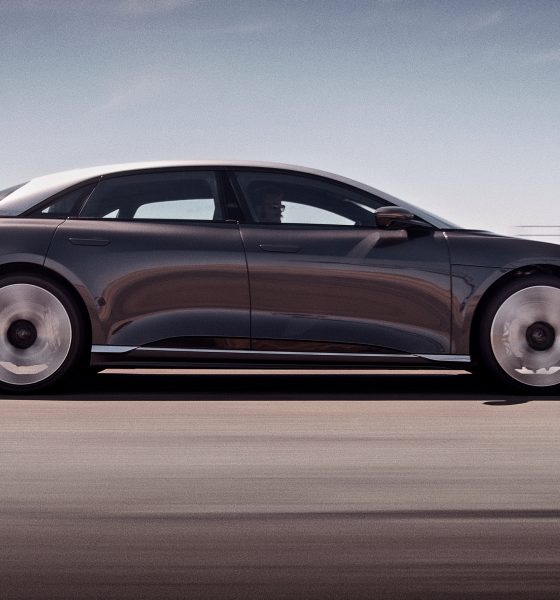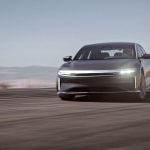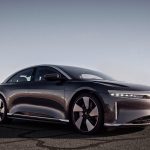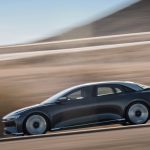

News
Lucid launches new Air Grand Touring Performance following ‘strong demand’ for speed
Lucid Group announced this morning it has launched a new version of its Air all-electric sedan: the Air Grand Touring Performance. The launch of the new, 1,050 horsepower trim level of Lucid’s first EV model answers the wishes of customers, who showed “strong demand” for “higher-performance versions of the Lucid Air,” CEO Peter Rawlinson said.
Set for initial deliveries in June 2022 in the United States, the Lucid Air Grand Touring Performance is the newest trim level of the all-electric sedan. Deliveries are set for August 2022 in Canada.
With 1,050 horsepower and a 0-60 MPH acceleration rate of just 2.6 seconds, the all-new Grand Touring Performance sets new standards for the Air lineup, as more performance has been a strong wish of Lucid customers thus far. The automaker surely answered.
Get there, grandly. Now delivering Lucid Air Grand Touring and introducing the new 1,050-hp Grand Touring Performance.https://t.co/pIiwBII0PW pic.twitter.com/Fxf28hblRd
— Lucid Motors (@LucidMotors) April 12, 2022
Two powerful, all-electric motors will drive the Lucid Air Grand Touring Performance to the forefront of the company’s EV lineup. With an EPA-estimated 446-mile range rating, it only falls short of the 520 miles its sibling, the Dream Edition, offers. “Two of Lucid’s proprietary electric motors – one at each axle – propel the Air Grand Touring Performance from 0 to 60 miles per hour in just 2.6 seconds,” Lucid outlined in its press release for the vehicle. “It will have an MSRP of $179,000, and customer deliveries in the U.S. are slated to begin in June 2022. In Canada, the Air Grand Touring Performance will be priced at $242,000 CAD (before taxes), with deliveries beginning in August 2022.”
A Need for Speed
CEO Peter Rawlinson said Lucid’s new Air Grand Touring Performance configuration is simply an answer to customer wishes. Evidently, despite its young and fresh entry into the market, with its first vehicle deliveries occurring in late 2021, Rawlinson’s electric car company has customers who are thirsting for even more performance. The new trim level offers that and then some, and Lucid quickly brought the new vehicle to the market as the in-house development of its products gives the automaker substantial advantages over those who are supplier-focused.
“Lucid Air Grand Touring Performance answers the strong demand we continue to see for higher-performance versions of the Lucid Air,” Rawlinson said. “The remarkable speed with which we are able to conceive and bring this model to market is possible only because of Lucid’s high degree of vertical integration and in-house production of our proprietary EV powertrain and battery pack technology.”
Standard Features
- Glass Canopy spanning windshield to roof
- Elegant and intuitive Lucid UX with 34-inch floating Glass Cockpit and 5K resolution
- Extensive over-the-air software update capability
- DreamDrive Pro, Lucid’s advanced driver assistance system, with 30+ features and future-ready hardware, including the first automotive LIDAR in North America
- 21-speaker Surreal Sound immersive audio system with Dolby Atmos compatibility
- Intelligent Micro Lens Array LED Headlights, a solid-state system developed in-house by Lucid
- Heated and ventilated front seats with massage
- Soft-close doors, power opening/closing trunk and frunk
- Ultra-fast 900V+ charging system, enabling users to add up to 300 miles in 21 minutes at a 350 kW DC fast charger, as demonstrated in recent independent media tests
I’d love to hear from you! If you have any comments, concerns, or questions, please email me at joey@teslarati.com. You can also reach me on Twitter @KlenderJoey, or if you have news tips, you can email us at tips@teslarati.com.

Elon Musk
Elon Musk and Tesla AI Director share insights after empty driver seat Robotaxi rides
The executives’ unoccupied tests hint at the rapid progress of Tesla’s unsupervised Robotaxi efforts.

Tesla CEO Elon Musk and AI Director Ashok Elluswamy celebrated Christmas Eve by sharing personal experiences with Robotaxi vehicles that had no safety monitor or occupant in the driver’s seat. Musk described the system’s “perfect driving” around Austin, while Elluswamy posted video from the back seat, calling it “an amazing experience.”
The executives’ unoccupied tests hint at the rapid progress of Tesla’s unsupervised Robotaxi efforts.
Elon and Ashok’s firsthand Robotaxi insights
Prior to Musk and the Tesla AI Director’s posts, sightings of unmanned Teslas navigating public roads were widely shared on social media. One such vehicle was spotted in Austin, Texas, which Elon Musk acknowleged by stating that “Testing is underway with no occupants in the car.”
Based on his Christmas Eve post, Musk seemed to have tested an unmanned Tesla himself. “A Tesla with no safety monitor in the car and me sitting in the passenger seat took me all around Austin on Sunday with perfect driving,” Musk wrote in his post.
Elluswamy responded with a 2-minute video showing himself in the rear of an unmanned Tesla. The video featured the vehicle’s empty front seats, as well as its smooth handling through real-world traffic. He captioned his video with the words, “It’s an amazing experience!”
Towards Unsupervised operations
During an xAI Hackathon earlier this month, Elon Musk mentioned that Tesla owed be removing Safety Monitors from its Robotaxis in Austin in just three weeks. “Unsupervised is pretty much solved at this point. So there will be Tesla Robotaxis operating in Austin with no one in them. Not even anyone in the passenger seat in about three weeks,” he said. Musk echoed similar estimates at the 2025 Annual Shareholder Meeting and the Q3 2025 earnings call.
Considering the insights that were posted Musk and Elluswamy, it does appear that Tesla is working hard towards operating its Robotaxis with no safety monitors. This is quite impressive considering that the service was launched just earlier this year.
Elon Musk
Starlink passes 9 million active customers just weeks after hitting 8 million
The milestone highlights the accelerating growth of Starlink, which has now been adding over 20,000 new users per day.

SpaceX’s Starlink satellite internet service has continued its rapid global expansion, surpassing 9 million active customers just weeks after crossing the 8 million mark.
The milestone highlights the accelerating growth of Starlink, which has now been adding over 20,000 new users per day.
9 million customers
In a post on X, SpaceX stated that Starlink now serves over 9 million active users across 155 countries, territories, and markets. The company reached 8 million customers in early November, meaning it added roughly 1 million subscribers in under seven weeks, or about 21,275 new users on average per day.
“Starlink is connecting more than 9M active customers with high-speed internet across 155 countries, territories, and many other markets,” Starlink wrote in a post on its official X account. SpaceX President Gwynne Shotwell also celebrated the milestone on X. “A huge thank you to all of our customers and congrats to the Starlink team for such an incredible product,” she wrote.
That growth rate reflects both rising demand for broadband in underserved regions and Starlink’s expanding satellite constellation, which now includes more than 9,000 low-Earth-orbit satellites designed to deliver high-speed, low-latency internet worldwide.
Starlink’s momentum
Starlink’s momentum has been building up. SpaceX reported 4.6 million Starlink customers in December 2024, followed by 7 million by August 2025, and 8 million customers in November. Independent data also suggests Starlink usage is rising sharply, with Cloudflare reporting that global web traffic from Starlink users more than doubled in 2025, as noted in an Insider report.
Starlink’s momentum is increasingly tied to SpaceX’s broader financial outlook. Elon Musk has said the satellite network is “by far” the company’s largest revenue driver, and reports suggest SpaceX may be positioning itself for an initial public offering as soon as next year, with valuations estimated as high as $1.5 trillion. Musk has also suggested in the past that Starlink could have its own IPO in the future.
News
NVIDIA Director of Robotics: Tesla FSD v14 is the first AI to pass the “Physical Turing Test”
After testing FSD v14, Fan stated that his experience with FSD felt magical at first, but it soon started to feel like a routine.

NVIDIA Director of Robotics Jim Fan has praised Tesla’s Full Self-Driving (Supervised) v14 as the first AI to pass what he described as a “Physical Turing Test.”
After testing FSD v14, Fan stated that his experience with FSD felt magical at first, but it soon started to feel like a routine. And just like smartphones today, removing it now would “actively hurt.”
Jim Fan’s hands-on FSD v14 impressions
Fan, a leading researcher in embodied AI who is currently solving Physical AI at NVIDIA and spearheading the company’s Project GR00T initiative, noted that he actually was late to the Tesla game. He was, however, one of the first to try out FSD v14.
“I was very late to own a Tesla but among the earliest to try out FSD v14. It’s perhaps the first time I experience an AI that passes the Physical Turing Test: after a long day at work, you press a button, lay back, and couldn’t tell if a neural net or a human drove you home,” Fan wrote in a post on X.
Fan added: “Despite knowing exactly how robot learning works, I still find it magical watching the steering wheel turn by itself. First it feels surreal, next it becomes routine. Then, like the smartphone, taking it away actively hurts. This is how humanity gets rewired and glued to god-like technologies.”
The Physical Turing Test
The original Turing Test was conceived by Alan Turing in 1950, and it was aimed at determining if a machine could exhibit behavior that is equivalent to or indistinguishable from a human. By focusing on text-based conversations, the original Turing Test set a high bar for natural language processing and machine learning.
This test has been passed by today’s large language models. However, the capability to converse in a humanlike manner is a completely different challenge from performing real-world problem-solving or physical interactions. Thus, Fan introduced the Physical Turing Test, which challenges AI systems to demonstrate intelligence through physical actions.
Based on Fan’s comments, Tesla has demonstrated these intelligent physical actions with FSD v14. Elon Musk agreed with the NVIDIA executive, stating in a post on X that with FSD v14, “you can sense the sentience maturing.” Musk also praised Tesla AI, calling it the best “real-world AI” today.











